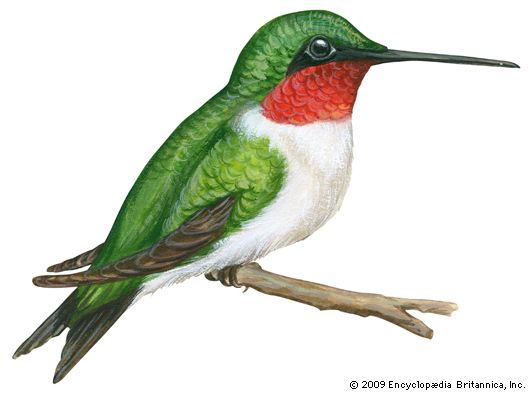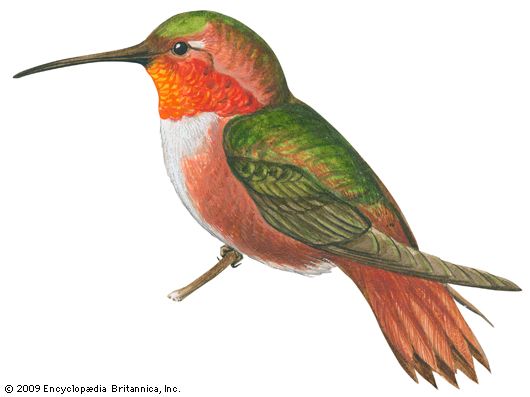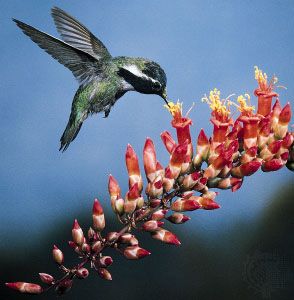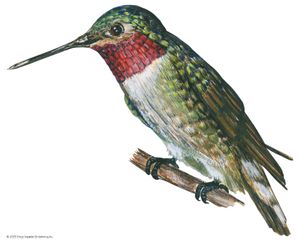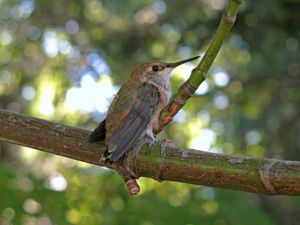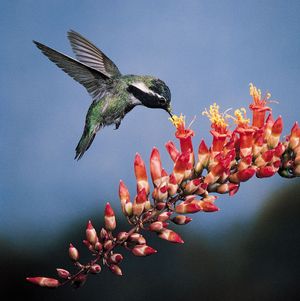hummingbird
Our editors will review what you’ve submitted and determine whether to revise the article.
- Arizona-Sonora Desert Museum - Hummingbirds
- Smithsonian’s National Zoo and Conservation Biology Institute - Hummingbirds
- National Audubon Society - Scientists Discover World’s Largest Hummingbird Hiding in Plain Sight
- USDA Forest Service - Maintaining and Improving Habitat for Hummingbirds in the Eastern United States
- University of Wisconsin-Madison - Wisconsin Horticulture - Hummingbirds in the Garden
- Animal diversity Web - Hummingbird
- Nature - Communications Biology - Hummingbird plumage color diversity exceeds the known gamut of all other birds
- The Spruce - 36 Fun Facts About Hummingbirds
- San Diego Zoo Animals and Plants - Hummingbird
- Related Topics:
- violet-ear
- thornbill
- avocetbill
- awlbill
- sicklebill
hummingbird, any of about 320 species of small, often brightly coloured birds of the family Trochilidae, usually placed with the swifts in the order Apodiformes but sometimes separated in their own order, Trochiliformes. The brilliant, glittering colours and elaborately specialized feathers of many species (usually of the males only) led the 19th-century British naturalist John Gould to give many hummingbirds exotic common names, many of which are still in use—e.g., coquette, fairy, hill star, wood star, sapphire, topaz, sun gem, and sylph.
Hummingbirds are restricted in distribution to the New World, where the greatest variety and number of species occur in South America. About 12 species are found regularly in the United States and Canada. Only the ruby-throated hummingbird (Archilochus colubris) breeds in eastern North America, where it is found from Nova Scotia to Florida. The northernmost hummingbird is the rufous (Selasphorus rufus), which breeds from southeastern Alaska to northern California. The broad-tailed hummingbird (S. platycercus) breeds in the western United States and Central America and the Allen’s hummingbird breeds in the coastal regions of California.
All hummingbirds are small, and many are minute. Even the largest, the giant hummingbird (Patagona gigas) of western South America, is only about 20 cm (8 inches) long, with a body weight of about 20 g (0.7 ounce), less than that of most sparrows. The smallest species, the bee hummingbird (Mellisuga, sometimes Calypte, helenae) of Cuba and the Isle of Pines, measures slightly more than 5.5 cm, of which the bill and tail make up about half. Weighing about 2 g, this species is the smallest living bird and ranks with the pygmy shrews as the smallest of warm-blooded vertebrates.

Hummingbirds have compact, strongly muscled bodies and rather long, bladelike wings that, unlike the wings of other birds, articulate (connect) to the body only from the shoulder joint. The architecture of the wing permits hummingbirds to fly not only forward but also straight up and down, sideways, and backward and to hover in front of flowers as they obtain nectar and insects from them. The rate at which a hummingbird beats its wings is the same during directional and hovering flight. It varies with the size of the bird—the larger the bird, the lower the rate. Consequently, the smallest hummingbirds have extremely rapid wing-beat rates. In Calliphlox amethystina, one of the tiniest species, the male has a wing-beat rate of about 80 per second; the female, which is larger, beats her wings at a rate of about 60 times per second. The ruby-throated hummingbird has a wing-beat rate of about 70 per second in the male and about 50 per second in the female. The rate is much lower in the larger hummingbirds; the giant hummingbird, for example, beats its wings only about 10 times per second. In fact, the larger hummingbirds appear to beat their wings more slowly than do other birds of comparable size.
The hummingbird’s body feathers are sparse and often strongly metallic and rather scalelike in appearance. The sexes are alike in appearance in a few species but are different in most species; males of the latter species display a variety of brilliance and ornamentation rivaled only by birds-of-paradise and certain pheasants. The most typical badge is the gorget, a bib of iridescent feathers the colour of which depends on the viewing angle. Other specializations include crests; abbreviated or thickened shafts of wing feathers; spatulate, wiry, or flaglike tail feathers; and “pantaloons,” tufts of puffy feathers on the thighs (usually white).
The hummingbird’s bill, which is adapted for securing nectar from certain types of flowers, is usually rather long and always slender. In the thornbills (Ramphomicron and Chalcostigma), it is quite short, but in the sword-billed hummingbird (Ensifera ensifera), it is unusually long, contributing more than half of the bird’s 21-cm length. The bill is slightly downcurved in many species, strongly so in the sicklebills (Eutoxeres); it is turned up at the tip in the awlbill (Avocettula) and avocetbill (Opisthoprora).
Most of the species that have been adequately studied do not show pair-bond formation. In the violet-ears (Colibri) and a few others, pair bonds are formed, and both sexes assume parental duties. In the majority of other species, the male defends a territory, where he displays in flight to passing females with swoops, dashes, and sudden stops and starts. Often he hovers in front of the female, oriented so that the light reflects the colour of his gorget. Territorial males chase off hummingbirds of their own and other species and dive at large birds, such as crows and hawks, and even at mammals, including humans. Most hummingbirds, especially the smaller species, have scratchy, twittering, or squeaky songs. In their U-shaped display flights, however, the wings often produce humming, hissing, or popping sounds, which apparently function much as do the songs of other birds. In many species the tail feathers produce the sounds.
The hummingbird’s nest is a tiny cup of plant fibres, spider webs, lichens, and moss that is attached to a branch, a forked twig, a large leaf, or a rock ledge. In certain species known as hermits (Phaethornis), the nest is hung by a narrow stalk from the underside of a ledge or from the roof of a cave or culvert; the nest cup, set on one side of a mass of mud and plant material, is held level by careful weighting of the other side of the mass.
The two elliptical white eggs (rarely, one) are the smallest laid by any bird, although, proportionately, they are equal to about 10 percent of the female’s body weight. They are incubated for about 15 to 20 days. The young, hatched blind and virtually naked, are fed by regurgitation and fledge in about three weeks; the time from laying to fledging apparently is correlated with food supply.

